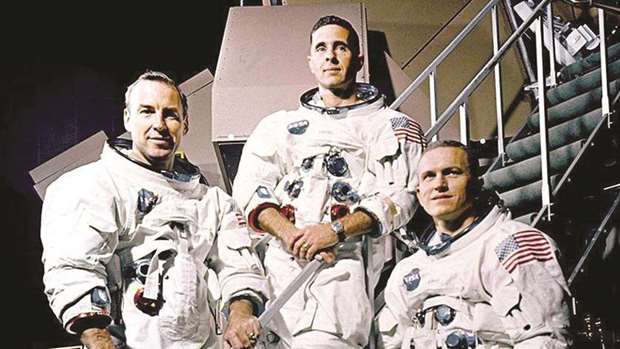Over the last few months, astronauts have entered my orbit with surprising frequency.
This has been more than a bit unusual, since there have been only 833 of them, men and women, so I would have been more likely to bump into a Nobel Prize winner (of which there have been 892) or a Congressional Medal of Honor recipient (3,518).
In April came Frank Borman, Jim Lovell and Bill Anders, not in the flesh but jumping off the pages of a spectacular new book, Rocket Men: The Daring Odyssey of Apollo 8 and the Astronauts Who Made Man’s First Journey to the Moon (Random House).
It is the work of Rob Kurson, a former lawyer, newspaperman and the author of three previous bestselling non-fiction books.
This latest was born in late 2014 when Kurson visited the Museum of Science and Industry to show some friends the U-505, that World War II German U-boat that has been in the museum since 1954 and which is a dead ringer for the submarine at the centre of Kurson’s first book, 2004’s Shadow Divers. He was walking out of the museum when he noticed a space capsule.
It was something he had seen many times before without paying it much attention. But this time he stared at the capsule and saw something, as he writes, “about ten feet tall and thirteen feet wide … scarred from its journey, wherever it had gone, and its open hatch revealed three cramped seats and a universe of controls inside. … (It) looked at once to have come from the past and the future.”
It was the command module of Apollo 8, which had carried the first men to the moon in 1968 and became the first mission to enter lunar orbit. “Like many people I knew all about Apollo 11 and Apollo 13 but nothing about this,” Kurson says.
He started to research and quickly learned that Apollo 8 was, he says, “the most daring and dangerous journey that Nasa has ever attempted.” Yes, those other space trips are more famous: Apollo 11, which landed men on the moon in 1969 (“That’s one small step for man, one giant leap for mankind”), and Apollo 13, the near-disastrous flight in 1970 (“Uh, Houston, we’ve had a problem”). The latter was dramatised so powerfully in the 1995 film Apollo 13 that when many people think “astronaut” it is Tom Hanks’ face that comes to mind. (He played the aforementioned Lovell, who was the commander on the flight).
Rocket Men lives up to Kurson’s billing as “one of the most incredible stories in American history.” He starts to make his case in the book’s compelling first sentence — “Three astronauts are strapped into a small spacecraft thirty-six stories in the air, awaiting the final moments of countdown. They sit atop the most powerful machine ever built.” — and carries on in great style through 350-some pages of “daring, adventure, risk-taking” and so much more.
Lovell who, like Kurson and his family, has long lived in the northern suburbs (and operated an acclaimed eponymous restaurant in Lake Forest from 1999 to 2015) was a fan of Shadow Divers. He was not only receptive to meeting and being interviewed by Kurson but happily introduced the writer to his fellow space travelers, all then in their 80s.
The trio was generous with their time and with their still vivid memories, helping elevate Rocket Men into the ranks of the most accomplished nonfiction books. Kurson’s portraits of the men, as well as their wives (all are still married to the women who watched them go into space), their families and space programme colleagues, are intimate and artfully drawn.
“These guys really don’t think of themselves as heroes,” says Kurson. “They believe the real heroes of the time were the young men fighting in Vietnam. These three could not be nicer and more humble. They are regular guys who were just doing their job.”
He is also hyper-aware of the times, giving us a detailed picture of a “United States (that) is fracturing. The year 1968 has seen killing, war, protest, and political unrest unlike any in the country’s history.”
No kidding. And the late December space journey was a very bright spot, a hopeful end to a dark year. Kurson tells of the astronauts receiving thousands of telegrams in the wake of their trip. “One stood out from the rest,” Kurson writes. “It read: THANKS. YOU SAVED 1968.”
I encountered my next astronaut in the flesh. He was Scott Altman, better known as “Scooter,” and he was speaking at the Union League Club of Chicago in front of a bunch of people on May 3. A native of downstate Lincoln and a graduate of the University of Illinois and the Naval Postgraduate School, he is now a 58-year-old retired Navy captain. He has all manner of awards for his abilities with airplanes and for his four trips into space, commanding two of those missions, included his final one in 2002 to service the Hubble Space Telescope.
He was charming and funny and very much to the evening’s point, which was to explain the work done by the Astronaut Scholarship Foundation, an organisation started in 1984 to provide financial aid and other nurturing to college students focused on science and technology. To date the ASF has awarded nearly $5 million to more than 5,000 students.
After his presentation, Altman relaxed with a couple of new friends, a few bourbons and his younger sister Sarah, a smart and delightful business executive. He told of spending a total of 51 days in space and of working on many of the aerial stunts in Top Gun, that 1986 Tom Cruise movie in which he (Altman and not Cruise) is seen famously “flipping the bird” at the enemy pilot.
Finally, there came news of the death of Tom Wolfe on May 14. A hugely influential writer, stylist and leading pioneer in the adventure that was New Journalism — my 20-page “senior project” in high school was a detailed examination and critical look at his 1968 The Electric Kool-Aid Acid Test — he did more than any ticker tape parade to honour and glorify astronauts (and the aviators who came before them) in his 1979 bestseller, The Right Stuff.
I reread his book and rewatched the 1983 film based on it. Both are as stirring as I remembered from long ago first encounters. Be aware, there are many astronauts in the book and movie and there will be more coming our way with next year’s 50th anniversary of the 1969 moon landing. I eagerly await their arrival. — The Chicago Tribune/TNS

HEROES: The Apollo 8 crew includes command module pilot James Lovell Jr., left; lunar module pilot William Anders, centre, and mission commander Frank Borman.


